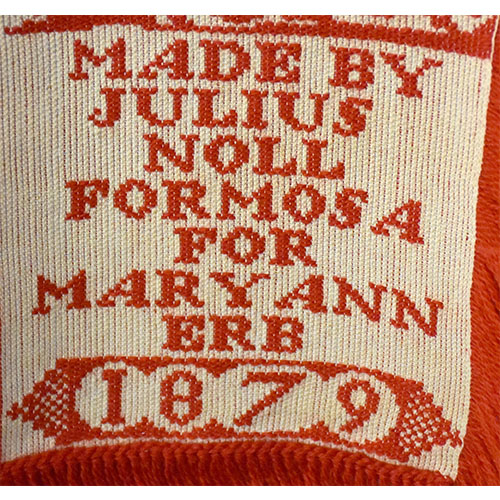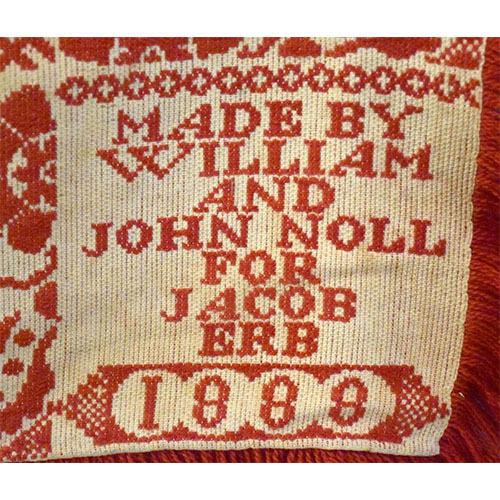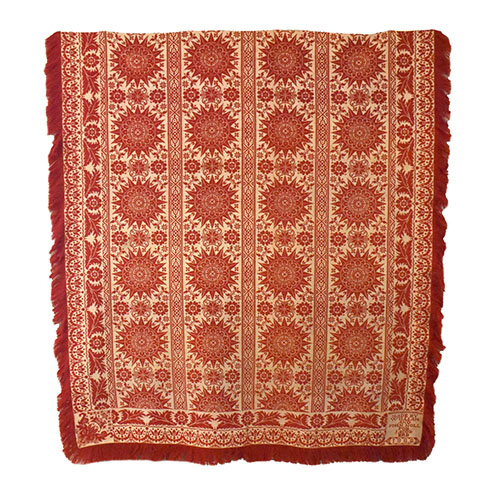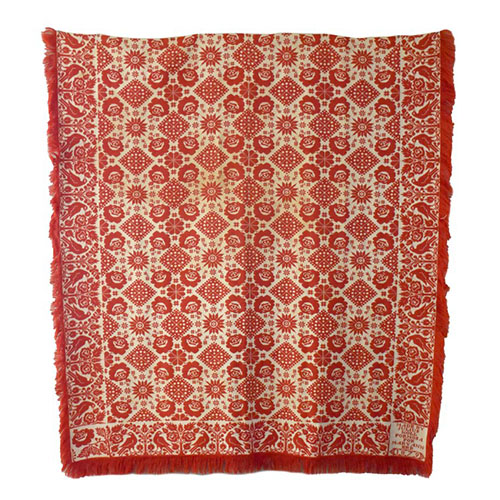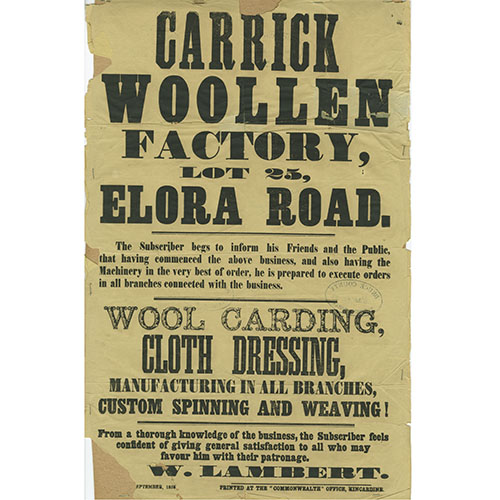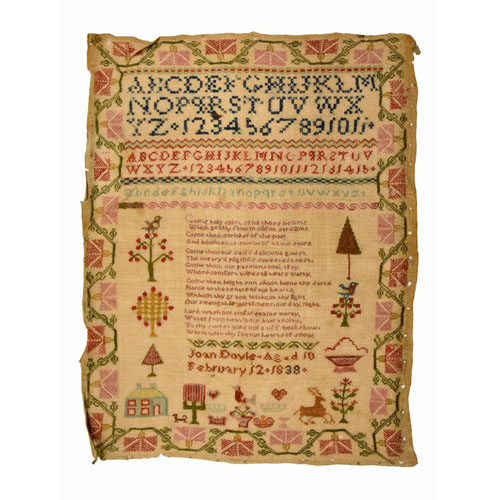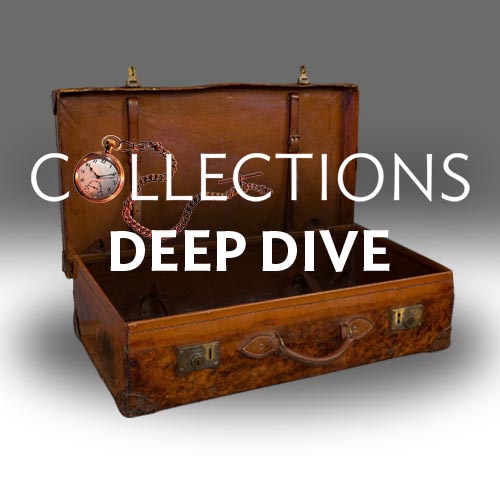Within the collection there are 18 pieces described as coverlets. Different from bedspreads or blankets, coverlets, which are thought to be derived from the term coverlid, cover the top and sides of the bed, but do not reach the floor. They are characterized by bright colours, and are tapestry-like in texture, having been woven on a loom. The coverlets in the collection are often described as Linsey-Woolsey, a term that refers to the linen and wool that are their makeup. Early coverlets were made on four-harness looms and feature geometric patterns. The nature of coverlets changed with the invention of the Jacquard loom attachment, which made its way to Canadian coverlet makers in the 1830s. The Jacquard allowed figural patterns that could be arranged in an infinite number of ways. Many of the coverlets within the collection feature Jacquard patterns.
Two coverlets within the collection, one donated in 1993, and the other in 2011, share several characteristics in common. They both are traditional Linsey-Woolsey in style and are bright red wool and off-white linen. Both feature Jacquard patterns. Both are made in a style known as tied Beiderwand, which creates a vertical ribbed effect on both sides of the coverlet. This style uses two warp (vertical) threads, one is fine and used to tie down the pattern weft (horizontal) to the ground fabric at regular intervals. Beiderwand was first used by weavers in Northern Germany and Southern Denmark in the 17th century to create bed curtains and clothing. They also have a bottom corner, known as a cartouche, that contain the maker’s name, who the coverlet was made for, and the year the coverlet was made.
Made for Siblings
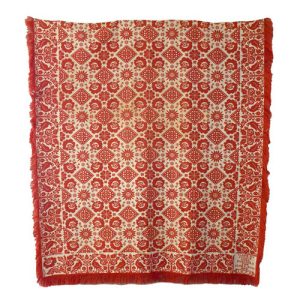 One was made by Jacob Noll for Mary Ann Erb of Culross Township in 1879. The coverlet was made when Mary Ann was 19, likely for her trousseau, and was a cooperative effort between her and Julius Noll. She sheared the sheep and carded and spun the wool. After her marriage in December 1893, Mary Ann moved out of Bruce County and the coverlet was passed down through the family, finding its way to British Columbia before being donated to the BCM&CC in 2011. Though from Culross, this coverlet has “Formosa” in the cartouche, which tells us the weaver Julius Noll lived in Formosa at the time the coverlet was made.
One was made by Jacob Noll for Mary Ann Erb of Culross Township in 1879. The coverlet was made when Mary Ann was 19, likely for her trousseau, and was a cooperative effort between her and Julius Noll. She sheared the sheep and carded and spun the wool. After her marriage in December 1893, Mary Ann moved out of Bruce County and the coverlet was passed down through the family, finding its way to British Columbia before being donated to the BCM&CC in 2011. Though from Culross, this coverlet has “Formosa” in the cartouche, which tells us the weaver Julius Noll lived in Formosa at the time the coverlet was made.
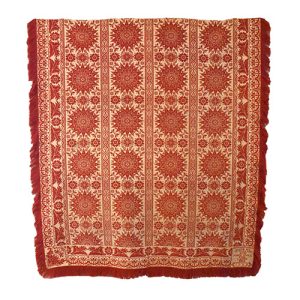 The other coverlet was made by William and John Noll for Jacob Erb in 1888. Following family trees and information found in “All Our Yesterdays”, it was discovered that Mary Ann is the older sister of Jacob. They were the children of Levi Erb and Magdalene Good, who first farmed on Lot 7, Concession 12, Culross Township. Later in 1892, the Erbs purchased Lot 6, Concession 13. Jacob married Mary Jane Sillick in November 1887, and they farmed together on Lot 10, Concession 13 after they were married. The coverlet dates to 1888, and could have perhaps been a wedding gift, as coverlets were often given as gifts for weddings and other special occasions.
The other coverlet was made by William and John Noll for Jacob Erb in 1888. Following family trees and information found in “All Our Yesterdays”, it was discovered that Mary Ann is the older sister of Jacob. They were the children of Levi Erb and Magdalene Good, who first farmed on Lot 7, Concession 12, Culross Township. Later in 1892, the Erbs purchased Lot 6, Concession 13. Jacob married Mary Jane Sillick in November 1887, and they farmed together on Lot 10, Concession 13 after they were married. The coverlet dates to 1888, and could have perhaps been a wedding gift, as coverlets were often given as gifts for weddings and other special occasions.
Made by Siblings
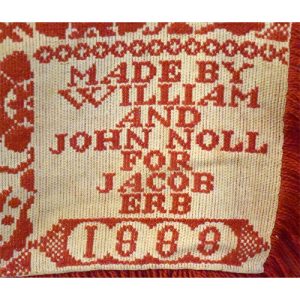 These two coverlets were not only made for siblings but were made by siblings. According to the Schneider Haus NHS, the Noll Brothers were the most well-known family of weavers in Waterloo County. Julius, William, and John Noll were the sons of Friedrich Noll, who was a trained weaver from Germany. The Noll family settled in Petersburg, Wilmot Township and Friedrich opened a weaving shop. All three sons were apprentices to their father and when he died in 1867, they took over the weaving business which featured a Jacquard loom.
These two coverlets were not only made for siblings but were made by siblings. According to the Schneider Haus NHS, the Noll Brothers were the most well-known family of weavers in Waterloo County. Julius, William, and John Noll were the sons of Friedrich Noll, who was a trained weaver from Germany. The Noll family settled in Petersburg, Wilmot Township and Friedrich opened a weaving shop. All three sons were apprentices to their father and when he died in 1867, they took over the weaving business which featured a Jacquard loom.
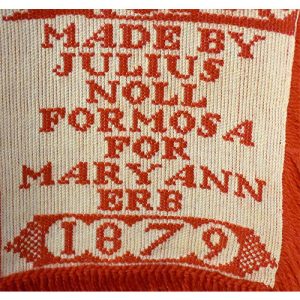 By 1871 Julius had left the business and can be found on the 1871 Ontario Census as a schoolteacher with his wife in Wellesley, Ontario. Sometime after this they moved to Formosa where he became a store clerk. Later he was a bookkeeper and was Postmaster of Formosa from 1897 to 1914. During some of his time in Formosa, Julius must have been weaving blankets as an extra form of income, and his craft, done in a Germanic style (Beiderwand), would certainly have appealed to the many German settlers in the southern part of the County. William and John continued the business in Petersburg until John’s death in 1905. Interestingly, John’s son, also John, continued to weave on a loom out of his home until the 1930s and was the Postmaster of Petersburg.
By 1871 Julius had left the business and can be found on the 1871 Ontario Census as a schoolteacher with his wife in Wellesley, Ontario. Sometime after this they moved to Formosa where he became a store clerk. Later he was a bookkeeper and was Postmaster of Formosa from 1897 to 1914. During some of his time in Formosa, Julius must have been weaving blankets as an extra form of income, and his craft, done in a Germanic style (Beiderwand), would certainly have appealed to the many German settlers in the southern part of the County. William and John continued the business in Petersburg until John’s death in 1905. Interestingly, John’s son, also John, continued to weave on a loom out of his home until the 1930s and was the Postmaster of Petersburg.
Though blanket making and other textile work is often thought to have been the realm of women, many professional weavers were men. The Canadian Industry in 1871, Bruce County index lists 92 weavers, not including woollen mills or factories. Just more than half were run by men. The index also shows that during this period there was a cottage industry for weaving which could be as large as a shop in town, or as small as a single person with a handloom. Mary Ann’s coverlet, and likely many more within the collection, is a good example of this cottage industry which by the turn of the 20th century was mostly gone.

